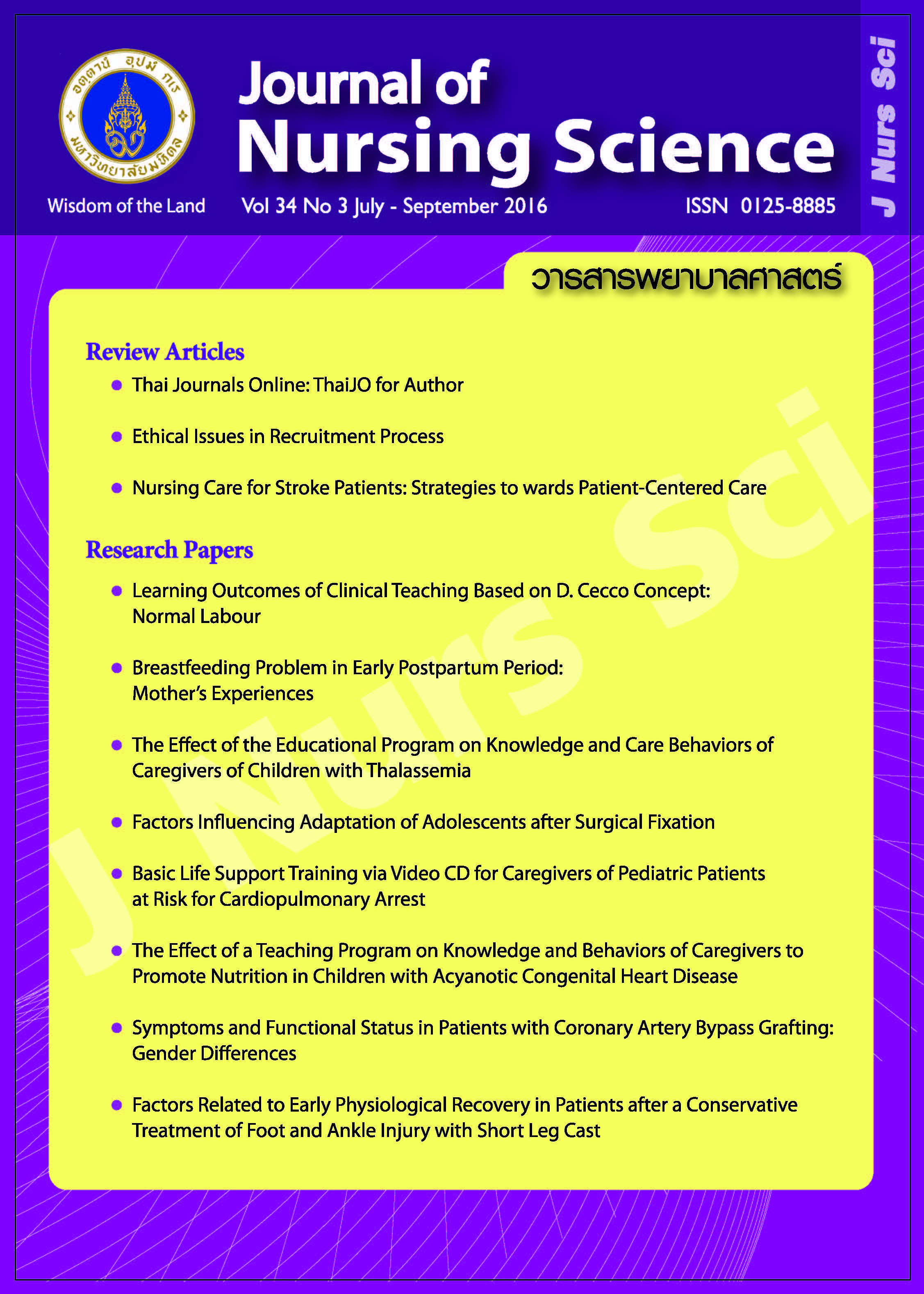Factors Influencing Adaptation of Adolescents after Surgical Fixation
Main Article Content
Abstract
Abstract
Purpose: This study aimed to examine factors predicting adaptation of adolescents after surgical fixation, including; severity of injury, family functioning, peer support and treatment duration. The Roy’s Adaptation Model was applied as the conceptual framework of the study.
Design: A predictive correlational study.
Methods: Subjects composed of 80 adolescents aged 13-19 years who had surgical fixation and were followed up in orthopaedic clinic of two hospitals in Surat Thani and Nakhon Si Thammarat province. Data were collected with 1) demographic data record, 2) adolescents’ adaptation after surgical fixation questionnaire, 3) Injury severity scale, 4) the family functioning scale, and 5) peer support questionnaire. Descriptive statistics and multiple regression analysis were used to analyze the data.
Main findings: The research findings indicated that severity of injury, family functioning, peer support and treatment duration could account for 24.5% of the variance explained in adolescents adaptation after surgical fixation (R2 = .245, F (4, 75) = 6.098, p < .05). However, only peer support could predict adaptation of adolescents after surgical fixation with statistical significance (β = .324, p < .05).
Conclusion and recommendations: Nurses and health care personnel should develop the program to promote the adolescent’s adaptation after surgical fixation by encouraging family and friends to participate in the program.
ปัจจัยที่มีอิทธิพลต่อการปรับตัวของวัยรุ่นภายหลังได้รับการผ่าตัดยึดตรึงกระดูก
บทคัดย่อ
วัตถุประสงค์: ศึกษาความสัมพันธ์เชิงทำนายของความรุนแรงของการบาดเจ็บ การทำหน้าที่ของครอบครัวการสนับสนุนของเพื่อน และระยะเวลาที่ใช้ในการรักษาต่อการปรับตัวของวัยรุ่นภายหลังการได่รับการผ่าตัดยึดตรึงกระดูกโดยประยุกต์ใช้ทฤษฎีการปรับตัวของ Roy
รูปแบบการวิจัย: การวิจัยเชิงทำนาย
วิธีดำเนินการวิจัย: กลุ่มตัวอย่างเป็นวัยรุ่นจำนวน 80 ราย อายุ 13-19 ปี ที่ได้รับการผ่าตัดยึดตรึงกระดูก และมาติดตามการรักษาที่ห้องตรวจศัลยกรรมกระดูกของโรงพยาบาล 2 แห่ง ในจังหวัดสุราษฎร์ธานี และนครศรีธรรมราชเก็บรวบรวมข้อมูลโดยใช้ 1) แบบสัมภาษณ์ข้อมูลส่วนบุคคล 2) แบบสอบถามการปรับตัวของวัยรุ่นภายหลังได้รับการผ่าตัดยึดตรึงกระดูก 3) แบบประเมินความรุนแรงของการบาดเจ็บ 4) แบบวัดองค์ประกอบพื้นฐานในการทำหน้าที่ของ
ครอบครัวไทย 5) แบบสอบถามการสนับสนุนของเพื่อนวิเคราะห์ข้อมูลด้วยสถิติเชิงพรรณนา และสถิติการวิเคราะห์ถดถอยพหุคูณ
ผลการวิจัย: ความรุนแรงของการบาดเจ็บ การทำหน้าที่ของครอบครัว การสนับสนุนของเพื่อน และระยะเวลาที่ใช้ในการรักษา สามารถร่วมกันอธิบายความแปรปรวนของการปรับตัวของวัยรุ่นภายหลังได้รับการผ่าตัดยึดตรึงกระดูกได้ร้อยละ 24.5 (R2 = .245, F(4, 75) = 6.098, p < .05) ทั้งนี้มีเพียงปัจจัยเดียว คือ การสนับสนุนของเพื่อน ที่สามารถทำนายการปรับตัวของวัยรุ่นภายหลังได้รับการผ่าตัดยึดตรึงกระดูกได้อย่างมีนัยสำคัญทางสถิติ (β = .324, p < .05)
สรุป และข้อเสนอแนะ: พยาบาลและบุคลากรทางสุขภาพควรพัฒนาโปรแกรมเพื่อส่งเสริม การปรับตัวของวัยรุ่นภายหลังได้รับการผ่าตัดยึดตรึงกระดูก โดยเน้นให้ครอบครัว และเพื่อนมีส่วนร่วมในการปรับตัวของวัยรุ่น
คำสำคัญ: การปรับตัว วัยรุ่น การผ่าตัดยึดตรึงกระดูก
Article Details
Copyright Notice: Nursing Science Journal of Thailand has exclusive rights to publish and distribute the manuscript and all contents therein. Without the journal’s permission, the dissemination of the manuscript in another journal or online, and the reproduction of the manuscript for non-educational purpose are prohibited.

Disclaimer: The opinion expressed and figures provided in this journal, NSJT, are the sole responsibility of the authors. The editorial board bears no responsibility in this regard.


